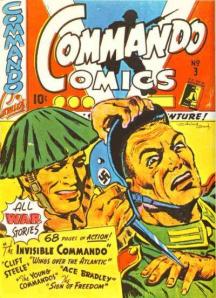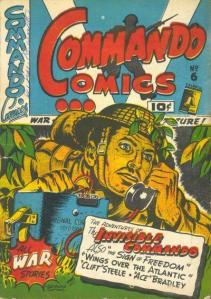 Bell Features, the truest of Canadian Golden Age comics published several titles during the 40’s including the aforementioned Active Comics.
Bell Features, the truest of Canadian Golden Age comics published several titles during the 40’s including the aforementioned Active Comics.
Where I left off speculating as to why the final issues of Active Comics went bizarrely out of routine, recalling their regular titles and importing new ones, I pick up now with Commando Comics. The series ran for 22 issues and were published irregularly from 1942 to 1946. For the most part, the plots in Commando comics were not serialized with a couple of two part exceptions. Unlike both Dime and Active, the Commando line all ran under Bell Features, and never the former title of the publishing company “Commercial Signs of Canada”.
 Like Active Comics, Commando Comics was themed, and in this case, based heavily on combat, war, secret missions, the Axis, and really, all other things commando. This theme was common during the war as it fueled nationalism and support and provided a more realistic hero. Active comics’ had Dixon of the Mounted, The Brain, Thunderfist, Active Jim and Captain Red Thorton which all featured daring action adventure stories. Likewise, Commando Comics had The Young Commandos, The Sign of Freedom, Wings Over the Atlantic, The Invisible Commando, Ace Bradley and Clift Steele. These stories shared a similar theme and formula which is evident in the cover pages pictured, and produced a very tight comic. This consistency lasted until about issue #15 when some of the more regular titles began to slowly drop off.
Like Active Comics, Commando Comics was themed, and in this case, based heavily on combat, war, secret missions, the Axis, and really, all other things commando. This theme was common during the war as it fueled nationalism and support and provided a more realistic hero. Active comics’ had Dixon of the Mounted, The Brain, Thunderfist, Active Jim and Captain Red Thorton which all featured daring action adventure stories. Likewise, Commando Comics had The Young Commandos, The Sign of Freedom, Wings Over the Atlantic, The Invisible Commando, Ace Bradley and Clift Steele. These stories shared a similar theme and formula which is evident in the cover pages pictured, and produced a very tight comic. This consistency lasted until about issue #15 when some of the more regular titles began to slowly drop off.
 It wasn’t really a surprise when Bell Features again began changing their lineup. Slowly, almost all of the above titles were phased out and replaced with gag comics or funnies by Robert Young, Thomas, Frank Keith, Harry Brunt and Hy Moyer. For stories they started using titles like the Polka Dot Pirate (A female avenger of sorts), Ruff and Reddy, Mr. Distracted Attorney, Salty Lane (Secret Investigator), Dick Stone, Chick Tucker and Flame Berns. There was even a Doc Stearne thrown in there. Beyond the obvious ridiculousness of the characters, the comic became unrecognizable to its former self.
It wasn’t really a surprise when Bell Features again began changing their lineup. Slowly, almost all of the above titles were phased out and replaced with gag comics or funnies by Robert Young, Thomas, Frank Keith, Harry Brunt and Hy Moyer. For stories they started using titles like the Polka Dot Pirate (A female avenger of sorts), Ruff and Reddy, Mr. Distracted Attorney, Salty Lane (Secret Investigator), Dick Stone, Chick Tucker and Flame Berns. There was even a Doc Stearne thrown in there. Beyond the obvious ridiculousness of the characters, the comic became unrecognizable to its former self.
As before, I think the changes were a result of the inevitable return of American comics. John Bell says in his book, “Some companies revamped their titles in the face of this formidable threat,” (52). I believe this was meant to be about production values, but I think it can also be applied to content. Perhaps Cy Bell was testing new titles for his expansion, or trying to give readers something new. In either case, it made the final issues of Commando Comics disappointing and unappealing. After all, gag comics are fine as far as filler goes, but you can’t make a commando comic out of them.
As for the lineup of writers and artists, (or in a lot of the cases both) they were the usual Bell Features crew, with Jerry Lazare, Ted Steele, André Kulbach, Adrian Dingle, Harry Thomson, René Kulbach, Edmund Legault, Jon Darian, Al Cooper, Leo Bachle, Jack Tremblay, Edmond Good, with extras by Manny Easson, Fred Kelly, Jesse French, Ed and Carl Alton, Ross Mendes, Aram Alexanian, Avrom Yanovsky (pseudonym Armand), Edward Letkeman, Clayton Dexter, Murray Karn, and Alfred Zusi (pseudonym Caz) with Vic Griffin faithfully writing the short narratives. Gag comics were typically by Mickey Owens, Frank Keith, Harry Brunt, Hy Moyer, Lou Skuce, Robert Young, Thomas and Cal.
Other titles include Kerry Dane, Tommy Tweed, Rory O’More, Lum and Tim Burr, Ivar of Mars and Rickey Regan Test Pilot, among others, although these appeared only once or twice in the series.
